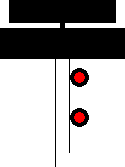Section 1: Early Signals
(Page 2 of 4)
Simple two-position board signals continued to be installed on different railways. The boards displayed by these signals to indicate 'danger' were of various shapes [1.16 - 1.18], and all were turned edge on for 'clear'. The disc signal used on the Newcastle & Carlisle Railway from 1840 [1.16] applied to trains in both directions. The triangular signals used on the Stockton & Darlington Railway [1.17] originally had no lamps. When lamps were later added, they showed a red light for the 'danger' position, but when operated to the 'clear' position, no light was shown.
 |
 |
 |
[1.16] Board Signal showing 'Danger'.
Area: N&CR
Usage: Unknown
Status: Historical
|
[1.17] Board Signal showing 'Danger'.
Area: S&DR
Usage: Unknown
Status: Historical
|
[1.18] Board Signal showing 'Danger'.
Area: NER
Usage: Unknown
Status: Historical
|
|
The 'double vane' or 'spectacle' signal was used on a few railways from 1840. This displayed two circular vanes for the 'danger' indication [1.19]. Both vanes were turned edge on for the 'clear' indication.
|
 |
[1.19] Double Vane Signal showing 'Danger'.
Area: LB&SCR / L&YR
Usage: Unknown
Status: Historical
|
|
The signal designed by Summerson & Russell was used at a few locations on the Stockton & Darlington Railway from 1840 until about 1852. The 'danger' indication was a red light above a green light [1.20]. For the 'proceed with caution' indication, the red light was obscured by a metal shutter, leaving just the green light visible [1.21]. The red board at the top of the post was fixed in position to act as a permanent marker.
 |
 |
[1.20] Summerson & Russell Light Signal showing 'Danger'.
Area: S&DR
Usage: Unknown
Status: Historical
|
[1.21] Summerson & Russell Light Signal showing 'Caution'.
Area: S&DR
Usage: Unknown
Status: Historical
|
In March 1840, a 'ball signal' was erected on the approach to Reading station (Great Western Railway). Known as 'The Reading Ball', it was only intended as a temporary measure. When the ball was lowered to the ground [1.22], it indicated 'danger', and when raised to masthead [1.23] the meaning was 'clear'. Referring to this signal, Daniel Gooch, Locomotive Superintendent, famously said: "if the ball is not visible the train must not pass it". Those words demonstrated that railway engineers were beginning to consider the 'fail-safe' principle, which was lacking in early forms of signals that indicated 'clear' by the absence of a visible marker. During darkness, the signal was given by a white light that moved in unison with the ball. A similar signal was erected at Slough, but the ball signals were soon replaced by 'disc and crossbar' signals.
 |
 |
[1.22] Ball Signal showing 'Danger'.
Area: GWR
Usage: Low
Status: Historical
|
[1.23] Ball Signal showing 'Clear'.
Area: GWR
Usage: Low
Status: Historical
|
I K Brunel designed the 'disc and crossbar' signal for the Great Western Railway in 1840. This signal gave positive indications for both 'danger' and 'clear'. In the 'danger' position, a black crossbar was displayed [1.24]. When the signal was turned to the 'clear' position, a white disc was displayed [1.25].
 |
 |
[1.24] Disc and Crossbar Signal showing 'Danger'.
Area: GWR
Usage: Unknown
Status: Historical
|
[1.25] Disc and Crossbar Signal showing 'Clear'.
Area: GWR
Usage: Unknown
Status: Historical
|
The 'double disc and crossbar' signal was introduced from 1841 for signalling branch line trains at junctions. Two crossbars were exhibited for the 'danger' position [1.26] and two discs for the 'clear' position [1.27]. In either position, two lights were displayed during darkness.
 |
 |
[1.26] Double Disc and Crossbar Signal showing 'Danger'.
Area: GWR
Usage: Unknown
Status: Historical
|
[1.27] Double Disc and Crossbar Signal showing 'Clear'.
Area: GWR
Usage: Unknown
Status: Historical
|










